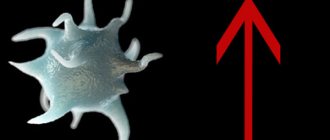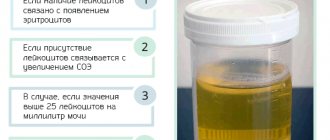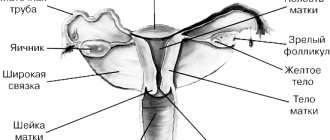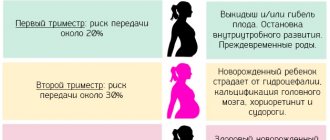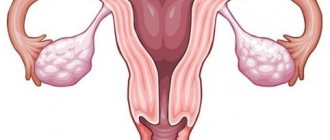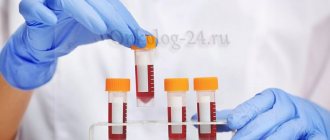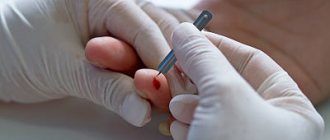Indications for biochemical blood tests in children
- diagnosis of diseases of internal organs and systems;
- metabolic diseases;
- diseases of the liver, kidneys, spleen;
- diseases associated with hormonal imbalance;
- infectious diseases;
- acute surgical diseases;
- preparation for surgical operations and medical procedures;
- hereditary diseases and congenital abnormalities;
- preventive (screening) studies;
- monitoring the effectiveness of treatment.
Explanation of results and reasons for deviation of normal values
Correct interpretation - correct diagnosis
| Indicator and decoding | Increase in indicator | Decrease in indicator |
| Total protein: a combination of various protein fractions, characterizes the synthetic function of the liver and the adequacy of the breakdown of protein molecules | The growth of globulins indicates:
| At:
|
| Albumin: the main blood protein, maintains plasma oncotic pressure and acid-base status, transports chemical compounds, creates a reserve of amino acids | Can be observed with dehydration, severe injuries, poisoning, burns, cholera. | At:
|
| Glucose: characterizes carbohydrate metabolism and energy reserves in the body | It may be due to a violation of the technology for taking blood (not on an empty stomach), impaired glucose tolerance, or diabetes mellitus. It occurs with pathology of the pituitary gland, adrenal glands, thyroid and pancreas. Side effects of certain medications: ACTH, corticosteroids, diuretics, thyroxine. | At:
|
| Creatinine: participates in the energy metabolism of muscle tissue and characterizes kidney function | At:
| In case of exhaustion, muscular dystrophy or atrophy. |
| Urea: the result of the exchange of nitrogenous compounds, a product of neutralized ammonia | At:
| In cases:
|
| Uric acid: product of purine base conversion reactions | At:
| At:
|
| Total cholesterol: a lipid necessary for the synthesis of cell membranes, nerve sheaths, and steroid hormones | At:
| When:
|
| HDL cholesterol: transport form of cholesterol from tissues to liver | At:
| Reduced when:
|
| LDL cholesterol: the main transport form of cholesterol | When:
| Happens when taking statins or nicotinic acid. |
| Triglycerides: neutral fats | At:
| Occurs when:
|
| Bilirubin: bile pigment, its increase is manifested by jaundice syndrome | Direct bilirubin is increased when:
Indirect bilirubin is increased when:
| Reduced with prolonged fasting. |
| AST and ALT: aminotransferases | At:
| Has no diagnostic value. |
| Alkaline phosphatase: most active in liver, bones, intestines | At:
| For: hypothyroidism, anemia, zinc deficiency. |
| GGTP: most active in the hepatobiliary system | For: diseases of the liver and pancreas, blockage of the bile ducts. | Has no diagnostic value. |
| Amylase: pancreatic enzyme | For acute and chronic pancreatitis. | |
| Creatine kinase: energy element | Different fractions increase with damage to the brain, heart muscle, and skeletal muscles. | When exhausted. |
| C-reactive protein: an indicator of inflammatory activity | For inflammatory processes of any localization. | Normally absent. |
| Rheumatoid factor: a type of autoantibody | At:
| Has no diagnostic value. |
| Calcium: forms bones, participates in the functioning of the heart, muscles, nervous system, hemostasis | In case of hyperparathyroidism. | At:
|
| Phosphorus: supports muscle and bone tissue | In case of thyroid diseases, bone tissue decay, injuries, diabetes. | For rickets and food deficiency. |
| Iron: found in hemoglobin | At:
| At:
|
| Magnesium: participates in the functioning of the nervous system, glands, muscles | In case of pathology of the thyroid gland and adrenal glands. | For chronic gastritis, enteritis, helminthic infestations, poor nutrition. |
Features of biochemical blood tests in children
Standard biochemical parameters in a child change throughout life. Therefore, in laboratory diagnostics of biological fluids, I usually distinguish four main age periods:
- newborn - first four weeks of life;
- infant - from four weeks to two years;
- child – from two years to puberty;
- adolescence – from the age of puberty to entry into adulthood.
For example, in the neonatal period, the standard values for glucose, calcium and magnesium are lower, while the levels of urea and bilirubin are higher than in other age groups. Newborns and babies born prematurely may have significantly different hormone levels.
The low weight of a newborn or infant, the small size of his body and some other features impose special requirements on the highly qualified medical personnel who collect samples of material for biochemical research. For example, special skill is required for collecting capillary blood from newborns and infants: excessive compression of the capillaries when squeezing out drops of blood can lead to the destruction of its cells, which in turn distorts the picture of the content of potassium, magnesium, phosphates and some enzymes in the blood.
Normal indicators of a biochemical blood test in pediatrics:

Only an integrated approach allows you to correctly interpret the analysis
| Index | Norms up to 1 month | Norms up to 1 year | Standards from 1 to 14 years | Standards from 14 years | Units |
| Total protein | 45-68 | 50-70 | 55-75 | 60-80 | g/l |
| Albumen | 32-43 | 33-43 | 35-50 | g/l | |
| Glucose | 1,7-4,7 | 3,0-5,5 | 3,3-6,1 | 3,3-6,1 | mmol/l |
| Creatinine | 33-105 | 35-110 | 40-110 | 60-110 | mmol/l |
| Urea | 2,5-4,5 | 3,2-5,5 | 3,8-6,2 | 2,5-6,5 | mmol/l |
| Uric acid | 0,15-0,25 | µmol/l | |||
| Total cholesterol | 1,5-3,1 | 1,8-4,5 | 2,5-5,5 | 3,0-5,0 | mmol/l |
| HDL cholesterol | 0,9-2,0 | 0,9-1,5 | 0,7-1,5 | mmol/l | |
| LDL cholesterol | 1,5-3,5 | 1,5-4,0 | 1,5-4,2 | mmol/l | |
| Triglycerides | 0,2-0,86 | 0,5-1,2 | 0,5-1,7 | mmol/l | |
| Total bilirubin | 15-65 | 4,5-12 | 11-50 | 4,0-21 | µmol/l |
| straight | 2,2-7,5 | 10-20 | 4,0-17 | 2,0-4,0 | |
| indirect | 5,0-12 | 3,5-17 | 0-4,0 | 3,0-12 | |
| AST | Up to 40 | U/l | |||
| ALT | Up to 40 | U/l | |||
| Alkaline phosphatase | Up to 145 | Up to 400 | Up to 120 | U/l | |
| GGTP | Up to 250 | Up to 180 | 30-48 | U/l | |
| Amylase | Up to 120 | Up to 110 | U/l | ||
| Creatine kinase | 25-150 | U/l | |||
| Calcium | 2,2-2,5 | 2,3-2,8 | mmol/l | ||
| Phosphorus | 1,8-2,7 | 1,3-2,3 | 1,1-2,0 | 1,0-1,8 | mmol/l |
| Iron | 10-33 | 6,5-15 | 9,5-32 | 11-33 | mmol/l |
| Magnesium | 0,65-0,95 | 0,7-1,2 | mmol/l | ||
| C-reactive protein | Negative | Up to 0.5 | mg/l | ||
| Rheumatoid factor | Up to 20 | IU/ml | |||
What to do so that your child is not afraid of taking blood from a vein or finger:
Blood tests can cause some fears in children (children may be afraid of pain or the sight of blood), so try to tell your child in advance that no harm will come to him.
The medical staff of our center is excellent at working with small children, you don’t have to worry, the blood will be drawn quickly and professionally, our nurses try to take blood from both a vein and a finger so that the kids are not afraid and do not cry.
For mothers: if you are worried that your baby will not react well to taking blood from a vein or from a finger, you can first play “tests” with your child at home on a soft toy, showing how the procedure for taking blood from a vein goes. Repeating the game procedure with your child several times will significantly reduce the level of fear from the unknown of the upcoming procedure.
While collecting material for research from a child, stay close to him, diverting his attention by verbally counting or repeating the alphabet.
Decoding the main indicators
Only the attending physician can correctly decipher the LBC in children, since the norm of indicators depends on the age of the child
In most cases, when a biochemical blood test is performed in children, they are limited to the so-called basic metabolic set. It includes eight basic indicators that provide the necessary information about the child’s health status. Using them, the doctor judges the functioning of all systems and organs: tests for kidney function, fluid levels and electrolyte balance (very important for diagnosing dehydration, which often occurs with vomiting and diarrhea in babies), glucose and calcium levels in the blood.
Blood counts vary between children of different ages, and many laboratories may use slightly different evaluation criteria, so test results may vary from place to place.
Only a pediatrician can correctly evaluate all the data, since you need to focus on a whole range of tests and studies.
Having received a form with the results of the analysis, parents should not be afraid of numbers that will differ from their own indicators. This is as it should be - the younger the child, the more striking this difference can be. So you should entrust this work to a professional who necessarily takes into account the age of the child and, based on the data obtained, as well as other research results, forms an opinion about the presence or absence of health problems in the child.
As already mentioned, a biochemical analysis may include more than 100 different indicators, but the most important, informative and frequently studied are the following:
- Protein. The amount of this substance in the blood shows the level of metabolic processes occurring in the child’s body. Protein is a kind of transport vehicle for moving lipids, hormones and other very important substances throughout the body. Elevated levels of protein in a child’s body may indicate a developing inflammatory process, existing kidney disease, or dehydration, which causes thickening and an increase in the amount of protein in the blood. The latter condition is a common occurrence in young children with dyspeptic disorders, vomiting and diarrhea.
- In addition to total protein, important information is provided by indicators such as albumin, globulin, and c-reactive protein. These protein fractions may indicate the presence of inflammation, disruption of the enzyme and immune systems, and hormonal imbalances.
- Bilirubin levels help assess the condition of the liver and are important in determining the cause of jaundice.
- Enzymes show liver function, and alkaline phosphatase helps diagnose acute leukemia.
- Glucose is a source of energy for cell life and reproduction. It makes it possible to assess metabolism, diagnose diabetes mellitus or malnutrition, and the baby’s exhaustion.
- Creatinine and urea indicate the condition and function of the kidneys.
- Lipids, triglycerides and cholesterol are indicators of fat metabolism in a child’s body.
- Basic microelements (potassium, calcium, sodium and phosphorus) are substances that are extremely important for the full formation, development and functioning of the child’s entire body.
How is blood taken for biochemical studies?
Blood is collected from newborns from the heel by puncturing the skin with a thin children's scarifier. In infants older than one month, blood is taken from the cubital vein.
In all cases, the nurse treats the surface of the skin with an antiseptic spray or solution. To increase the amount of blood in the vein before the study, it is briefly clamped with a tourniquet (soft tourniquet). Then a thin needle is inserted into the vein, through which the blood flows into a test tube or syringe. After blood collection, the injection site is treated with an antiseptic, and a bandage or plaster is applied to it.
Decoding and interpretation of the results of biochemical blood tests
The printout of the results of the study of biochemical parameters provided by the laboratory will indicate the levels of the test substances in the blood plasma and the normative indicators for the child’s age.
The results obtained should be assessed by the pediatrician or medical specialist who ordered the study. Based on the biochemical tests obtained, the doctor will prescribe treatment or suggest additional studies to clarify the diagnosis.
Biochemical studies are an informative, fast and safe method of studying the state of the child’s body and the functioning of individual internal organs and systems, which allows you to accurately establish a diagnosis and carry out the required treatment with maximum efficiency, or get rid of worries and doubts about the state of your baby’s health.
You can get additional information about biochemical studies and sign up for tests at the medical office by calling.
Appointment for analysis
A biochemical blood test is an effective diagnostic tool to assess the functioning and condition of internal organs
In most cases, a biochemical blood test in children is prescribed to confirm a preliminary diagnosis or refute it. Such a test can show how healthy the child is or what abnormalities are present in his body. The list of parameters for such an analysis includes more than a hundred indicators, so the doctor can mark on the procedure form only those that he needs to obtain.
Based on the results of the analysis and other studies, examination of the child and conversation with his parents, the doctor can draw conclusions about the state of his health and the presence or absence of any pathology. All parameters are assessed comprehensively, since in a small child they can quickly and easily change depending on many different reasons - excitement, body temperature and surrounding age, food eaten and many other factors.
Often it is a blood test in infants and toddlers that allows us to find the source of a disease that could not be determined otherwise.
Such a test may be required to diagnose inflammatory processes in the body, assess water-salt metabolism and electrolyte balance, determine the correct functioning of the kidneys and liver, as well as the systems associated with these organs.
Preparation and procedure
One of the important factors that influence the reliability of the result is proper preparation for the analysis.
In principle, according to medical requirements, a biochemical blood test in children is performed according to the same requirements as in adults. However, the younger the child, the more questions his parents have about preparing for the test.
Usual requirements:
- The blood test should be carried out on an empty stomach, the minimum period of fasting is about 12 hours before the blood is drawn.
- It is best to take the test in the morning.
- Your child can be given clean water, but not juice or sugary drinks.
- Parents should try to distract the baby to avoid excessive excitement and whims - this may negatively affect the results of the study.
- If the child is old enough, you need to make sure that on the eve of donating blood he eats the same foods and dishes as usual. Do not introduce new foods or drinks into his menu, avoid exotic fruits and juices, as well as an abundance of sweets, pastries and chocolate.
- If possible, you should avoid taking any medications that could affect the child’s metabolism at least 7 days before the test. If this is not possible, you need to provide the doctor with the relevant information. It will be taken into account in the process of drawing conclusions from the analysis.
There seems to be nothing confusing about this list, but parents of small children, especially infants, know very well what a hungry child in line to donate blood is capable of. If an infant is to donate blood, he must not be fed, so this point in preparation for the test can be skipped. Fasting such a small child will distort the blood sample data much more than taking breast milk or a special milk formula. This food is quickly absorbed, so the child can and should be fed, but not just before the blood draw.
More information about biochemical blood tests can be found in the video:
It is difficult to persuade a small child who does not yet understand the importance of the procedure to be patient for several hours. He can make a terrible scandal while waiting for his turn for analysis in the laboratory, which will have an extremely negative impact on the result of the sample. The baby needs to be fed before leaving the house with food that will take a long time to digest and create a feeling of fullness. It is important to avoid sweet foods, sugar in any form and drinks - this can greatly distort the glucose test, and this is a very important indicator.
You can consult your pediatrician about feeding a young child.
He will give precise recommendations on what dishes can be given to the baby, and what type of food should be completely excluded from his menu.
Another important aspect of preparation is psychological balance. The child instinctively copies the behavior of his parents. If they are nervous, this will definitely be passed on to the baby. Take care to take his favorite toy, read him a book in line, distract him from thoughts about the future procedure.
Take care to minimize disruption to the child during blood collection. To do this, dress it so that you can easily and simply roll up your sleeve to take a sample. Blood is taken from a vein, most often in the elbow. If the baby cries, distract his attention with some toy or treat - after drawing blood, you can eat. In newborns, blood is taken from the heel, in older children - from a vein in the bend of the elbow. The hand above the vessel is pulled with a tourniquet. If the child is nervous and timid, you can play at home to imitate this process, then it will not be so painful and frighteningly unusual for the baby.
